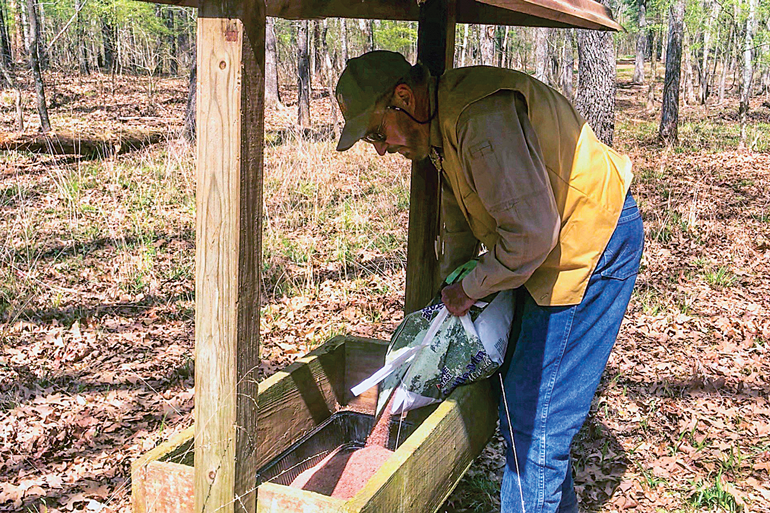Over the years, I’ve written on a number of occasions about mineral supplementation for whitetails. That’s because it’s long been a topic of widespread interest — not only on the part of landowners and other habitat managers, but hunters, as well.
Despite the number of products now on the market and the amount of information published, many user questions continue. So here, during a time of year when mineral interest and use are high, I’d like to recap which minerals deer need and how to address those needs.
In the Beginning
Back in the early 1970s, two men came to visit me at the Institute for White-tailed Deer Management & Research in Texas. Larry Redmon and Richard Reed (the latter now deceased) were local cattlemen and avid deer hunters, and they had a question I’d never heard.
“We routinely give our cattle minerals,” Larry said, “and we wondered if it would be possible to make a mineral for deer?”
As I was at the time formulating a 20-year research plan for our institute, I decided it was a natural fit to include mineral supplementation in the plan. Interestingly enough, Larry later earned a doctoral degree in Range Management from Texas A&M University, and to this day he remains a recognized authority on range management and animal nutrition.
Believe it or not, in those early days little of the whitetail information we now commonly take for granted was known. Those actually were wonderful days to do research, as my colleagues and I “picked the low-hanging fruit” of knowledge.
In formulating a plan of attack regarding mineral nutrition, I went to the same folks we’d consulted about planting forages: dairymen. These folks should know more than anyone about proper nutrition for ruminants, a group that includes whitetails. Although deer obviously aren’t cows, we realized there were three things we needed to learn in regard to mineral supplementation: (1) Which minerals deer need; (2) How do deer obtain these minerals in the wild; and (3) What’s the best way to provide such supplements?
Which Minerals Really Matter
In reviewing the scientific literature, I quickly discovered there was very little known about critical minerals for deer. Most professionals relied on information generated primarily for small ruminants, including sheep and goats. Obvious dietary differences dictated that this information might only be elementary when it came to whitetails.
Minerals are important to all living things, serving a host of physiological functions. They’re classified as either macro- or micro-nutrients. These categories indicate the amount used by the animal. Important macro-nutrients include: calcium (Ca), phosphorus (P), potassium (K), magnesium (Mg), sodium (Na) and sulfur (S). Micro-nutrients include: iron (Fe), copper (Cu), Zinc (Zn), manganese (Mn), cobalt (Co), iodine (I) and selenium (Se).
While all these minerals are important, we quickly learned that Ca and P in particular had a lot to do with the size of deer and their antlers. A 1:1 or 2:1 Ca:P ratio is optimum. We also identified magnesium deficiencies in some Michigan deer when we discovered dozens of them eating mud rich in this mineral. As it turned out, the general area has long been known for a cattle disease called “grass tetany,” which is directly related to a lack of magnesium in the diet.
Micro-nutrients such as Cu, Zn and Se are particularly important to whitetails, responsible for many metabolic activities and immune development. In fact, there’s significant scientific evidence to suggest Cu deficiencies are linked to spontaneous occurrences of brain diseases such as “mad cow” and CWD. Compared to sheep and goats, whitetails are “copper hogs” that need a lot of the mineral.
Minerals in the Soil
As I detailed in the Spring issue, it’s safe to say that soils determine more about whitetail growth and productivity than any other factor. All soils are made up of minerals, and there are clear deficiencies in many areas. This particularly is true for sandy soils, as well as highly acidic (low pH) or basic (high pH) soils. When soil is either too low or high in pH, utilization of P is inhibited, greatly affecting body growth and antler production. Yes, whitetails will eat dirt, but the vast majority of minerals they consume enter the system through the plants they eat.
To be clear, most of the Ca and P used by a buck to grow antlers come from the flat bones of his body: where they were deposited the previous year. So mineral supplementation won’t show any antler effect for at least a year.
Interestingly, the immense prehistoric deer called the “Irish elk” (Megaloceros giganteus) went extinct during the last global warmup shortly after the Ice Age, apparently due to the loss of tundra plants high in Ca and P. Fossil evidence supports these deer were victims of spontaneous cervical fractures caused by osteoporosis.
Best Way to Provide Supplements
We’ve learned that a multi-pronged approach to providing deer minerals is best. The first step is have the soils analyzed for the critical macro- and micro-nutrients. This should be followed by developing a food-plot or native-plant fertilization program to ameliorate any deficiencies.

For example, in much of South Texas (which is broadly deficient in P), low rainfall makes trying to grow traditional food plots a “fool’s errand.” Instead, we apply 50 pounds per acre of triple-superphosphate (0-45-0) fertilizer to native brush. In so doing, we get fantastic response from the deer herd.
For most whitetail managers, one of the best ways to supplement mineral nutrition is (where legal) through supplemental feeding. A balanced pelleted ration can deliver all the mineral nutrition needed by the herd. However, in many areas feeding isn’t a legal option.
Deer aren’t cows; they don’t like to lick blocks the way their bovine cousins do. The best way to provide supplemental minerals is by using a granular mineral that contains less than 30 percent salt and has Ca and P at the rate of 12 percent each. Of course, the other macro- and micro-nutrients should be included in lesser amounts.
While it sounds simple to concoct your own mineral mix, that’s really not a good idea. I know of some deer managers in Ohio whose homemade mineral mixes gave the animals heavy metal poisoning! Leave formulation to the professionals.
In the old days, we simply dug holes and poured granular mineral into them. But we now know that was a really bad idea. By delivering mineral in this way, you’re exposing deer to greater risk of parasites and diseases.
A much better approach is to use a covered trough with a roof high enough for a buck to easily get his head inside (and be able to see all around as he does so). Inside the trough, place a metal or plastic pan to hold the mineral. Every two weeks, remove any remaining mineral and wash or wipe out the pan with 50 percent bleach water to kill bacteria and parasite eggs.
In Conclusion
As you seek to improve herd nutrition, there’s still no substitute for good native forage management. A solid habitat/nutrition plan should involve manipulating preferred plants to keep them within what we call the “deer zone” (within four feet of the ground), on a sustained basis.
However, soil limitations often dictate using supplements to fill in the blanks created by scarcity of critical minerals in the native environment. I believe that when properly provided, minerals can increase the productivity and quality of a deer herd.















































